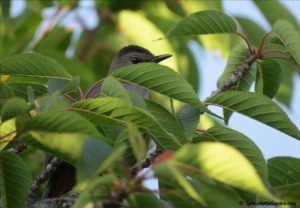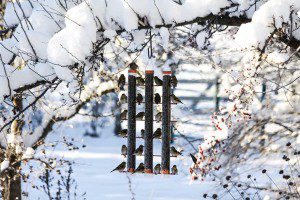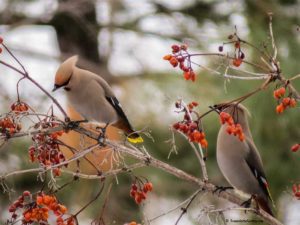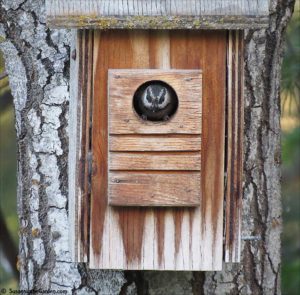Attracting birds
My husband, Bill, and I have been interested in watching birds for as long as I can remember. In 1989, we bought five acres in a rural area. The property had been farmed over the years and was wide open. Since attracting birds was very important to us, we knew we’d have to do some serious landscaping to close things in so birds would feel safe.
Attracting birds to a garden isn’t all that difficult, once you’ve met their basic needs of cover, food, water and housing.
 I listed cover, or shelter, first for the very reason stated in the first paragraph. Birds know that a landscape devoid of trees and shrubs puts them at risk from predators such as hawks and cats.
I listed cover, or shelter, first for the very reason stated in the first paragraph. Birds know that a landscape devoid of trees and shrubs puts them at risk from predators such as hawks and cats.
The first thing we did was plant a lot of young trees and shrubs purchased at the Spokane County Conservation District’s annual plant sale. Everything we bought was native to this area and most are drought-tolerant. The native shrubs also provide us with flowers in the spring and summer, fall color, and often berries to feed hungry birds during the fall and winter months. All good attributes!
We also planted all sorts of perennials, annuals and bulbs to provide color, scent (mostly for my benefit), as well as nectar for hummingbirds, pollinators and butterflies.
 As the landscape started filling in, we purchased bird feeders to accommodate the seed-eaters. This includes chickadees, juncoes, goldfinches and other types of finches. We primarily put out black-oil sunflowers, which are very popular with the birds, and Nyjer thistle seed mainly for the goldfinches. The latter is more expensive but boy, do the finches adore it! California quail are also seed-eaters but they don’t come to feeders. They are content to eat any “spillage” underneath feeders.
As the landscape started filling in, we purchased bird feeders to accommodate the seed-eaters. This includes chickadees, juncoes, goldfinches and other types of finches. We primarily put out black-oil sunflowers, which are very popular with the birds, and Nyjer thistle seed mainly for the goldfinches. The latter is more expensive but boy, do the finches adore it! California quail are also seed-eaters but they don’t come to feeders. They are content to eat any “spillage” underneath feeders.
One thing that’s particularly important to remember for your seed-eating bird friends is to leave the seed heads of flowers like coneflowers, black-eyed Susans and bee balm in your flower beds when tidying things up in the fall. Those seeds are an important nutrition source for birds during the fall and winter months. So you have my permission to do less work at the end of the season!
This video, which I shot in December 2015, illustrates this point all too well:
Another food source we place in specialized feeders is suet. It comes in “cakes” filled with seeds, sometimes nuts and berries, and is mixed with fat. Birds that really enjoy suet include Northern flickers, hairy and downy woodpeckers, and chickadees.
Remember to regularly clean your bird feeders to keep your bird friends healthy.
There are plenty of birds that subsist on insects. Fortunately, we have plenty to spare due to having a large garden and varied landscape surrounding our home.
 I mentioned how we planted native shrubs with berries. One of the best for drawing in birds is American Cranberry Bush (Viburnum trilobum). We’ve found that Cedar and Bohemian waxwings are drawn to those berries like magnets during the colder months of the year.
I mentioned how we planted native shrubs with berries. One of the best for drawing in birds is American Cranberry Bush (Viburnum trilobum). We’ve found that Cedar and Bohemian waxwings are drawn to those berries like magnets during the colder months of the year.
Other good berry or fruit producers include serviceberries, snowberries, red Osier dogwood, crabapple and hawthorne.
The next priority was to provide sources of water for birds to both drink and bathe in. We have a couple of birdbaths (one is heated for wintertime drinking and bathing), a small pond, and a large pond complete with a waterfall. The sound of splashing water really draws in the birds. The following video shows how much they love a heated birdbath on a sunny winter’s day:
No matter what type of water source you provide, be sure to scrub out the algae and other debris on a regular basis.
 The last, but certainly not least, important need to address is housing. Some types of birds will roost and nest in dense trees and shrubs. But many others appreciate birdhouses with openings just large enough for them to get through (and not so large that a larger predator could get in as well).
The last, but certainly not least, important need to address is housing. Some types of birds will roost and nest in dense trees and shrubs. But many others appreciate birdhouses with openings just large enough for them to get through (and not so large that a larger predator could get in as well).
Bill and I have enjoyed building our birdhouses, especially during the winter when we call them our “cabin fever projects.” On Cornell’s All About Birds website, they have an excellent infographic that covers the features of a good birdhouse. That way, you know exactly the right size openings for the species you want to accommodate, the correct dimensions to use and where to install the birdhouse.
I’ve also written about attracting birds to the garden in my columns for Sunday edition of The Spokesman-Review newspaper. Here are links to two of them:
I’ve also written a blog post about attracting hummingbirds, which we all want to do, right?
I hope all of this information will get you started on a lifelong adventure of watching birds in your garden!
